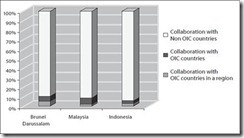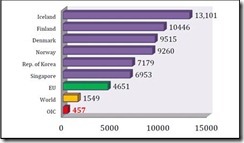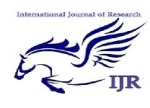Ang Kean Hua1
1. Department of Science and Technology Studies, Faculty of Science,
University of Malaya, 50603 Kuala Lumpur, Malaysia.
Abstract
There is a grave need nowadays to increase institutional and international STI collaboration. Countries are now seeking opportunities to work together not only to cut down the cost but most importantly to learn from each other. This paper attempts to analyses current stance of STI collaboration among OIC member states. First section will present a brief introduction, followed by the importance of STI collaboration in the second section. The roles of several influential actors in shaping the direction of STI cooperation in the Islamic world will be discussed in section 3. The next section talked about recurring issues that hinder the progress of STI co-operation and broad recommendations to reinvigorate scientific and technological collaboration among OIC will be proposed in the fifth section.
Keywords: Science, Technology, Innovation, Collaboration, OIC
1. Introduction
Science, technology, and innovation (STI) collaboration is in fact not an uncommon or a new activity within scientific world. During the epoch of Golden Islamic Civilization, scholars and scientists travelled to and fro various countries and institutions to exchange views, study under well-learned teachers, and to make joint observations or researches. The European Renaissance was accompanied by similar trend where international collaborations were frequently established through numerous scientific communities or projects. During those periods, STI collaboration is regarded as highly significant in advancing science and technology understanding.
With the establishment of the Organization of the Islamic Cooperation (OIC), interest in joint STI activities in the Islamic world is rekindled in accordance to the organisation’s aim to promote collectiveness and cohesion among Ummah. However, OIC is not alone in recognising the importance of global engagement in STI. For instance, in 2000, a review of Canada’s role in international science and technology was published and among its recommendations include the establishment of a special fund for international cooperative research (PMSEIC, 2006). The same strategy was echoed as well by United Kingdom who is aspired to become the ‘partner of choice’ for scientific collaboration in the future (GSIF, 2006).
1.1 The Need for STI Collaboration
Growing interest in international STI collaboration may be driven by various reasons. For example, STI collaboration is inevitable for Muslim countries if they wish to catch-up within this competitive knowledge-based economy. Gaining comparative advantage against other countries relies on how well researchers perform STI activities both individually and collaboratively. In addition, collective effort in the area of STI is imperative among OIC countries either to solve their inherent problems or to achieve common goals. Poverty, diseases, and other social wellbeing issues within OIC cannot be accomplished merely by a single country’s effort. The need for STI collaboration among OIC states is also very much driven by the deficiency of resources. Hiring sufficient qualified STI personnel or financing scientific projects may be beyond the capacity of a least developed country and thus cooperation from other OIC countries or organizations especially those with capital and human resources are required.
1.2 Existing STI Organizations and Collaborative Efforts in OIC
Royal Society in their 2010 report entitled ‘A new golden age? The Prospects for Science and Innovation in the Islamic World’ asserted that greater international outreach and collaboration is essential in order for the OIC members to enjoy the advancement of STI. For this purpose, various efforts have been conceived both at institutional and individual levels and some of the major progressions are discussed in the following.
COMSTECH
OIC through Standing Committee on Science and Technological Cooperation (COMSTECH) has acted as the umbrella body in promoting intra-OIC STI cooperation. COMSTECH is established during the Third Summit Islamic of OIC held in Saudi Arabia in January 1981 with the aim to strengthen the individual and collective capacity of OIC member states in science and technology through mutual cooperation, collaboration, and networking of resources (COMSTECH, 2012). Table 1 highlighted some of the programmers that have been implemented by COMSTECH to fulfill its main objective.
Table 1: Programmed under COMSTECH
Details
|
|
Inter Islamic Network (IIN)
|
IINs act as the focal institutions that aim to bring together scientists from all OIC countries to work on selected STI niche. To date, there are 13 IINs across OIC – 9 of them are active in status while the remaining 4 are currently suspended by the Executive Committee.
|
|
Visiting Scientists Program
|
Launched in 1998 to provide financial assistance to researchers desirous of visiting Centres of Excellence in OIC member states to conduct joint research or to deliver lectures in the selected fields of STI.
|
|
COMSTECH-TWAS Program for Young Scientists
|
COMSTECH and the Academy of Sciences for the Developing World (TWAS) is established in response to the needs of promising young researchers in OIC countries, particularly those attached to institutions that are lacking appropriate research facilities.
|
|
COMSTECH-IFS Program
|
COMSTECH collaborates with the International Foundation for Science (IFS) to support research project of importance to meeting the development needs of the OIC member states.
|
Source: COMSTECH
COMSTECH is also responsible in governing another OIC organisation named Science, Technology and Innovation Organization (STIO). STIO, following its approval during the 34th Islamic Conference of Foreign Ministers in May 2007, is envisaged to be the implementation organ of the COMSTECH with Iran, Pakistan, Saudi Arabia, and Syria are considered as the founding members. After six years of establishment, 20 OIC countries have declared their membership to STIO (Osama, 2013). STIO is mandated, among others, to promote regional and international cooperation, coordination, and to encourage activities in the fields of STI between member states, with the view to elevate the level of STI and human capital in the OIC (COMSTECH, n.d).
ISESCO
Islamic Educational Scientific and Cultural Organization (ISESCO) was formally established in 3rd May 1982 after its approval during the Third Islamic Summit Conference held in Makkah Al-Mukarramah on 25-28 January 1981. To enhance collaboration in STI, ISESCO and its subsidiary organs particularly ISESCO Centre for Promotion of Scientific Research (ICPSR) has implemented various programmes – all of which aimed to coordinate individual scientists, research institutions, and centres of excellence in the member states so that they can establish effective scientific liaison among them. ‘Resource Sharing’, ‘Capacity Building (Scientist Training)’, and ‘Reducing Brain Drain’ are amongst the top priorities of ISESCO and ICPSR (ISESCO, n.d.).
In addition, the importance of collaboration is also addressed in ISESCO’s Three-Year Action Plan and Budget for the Years 2013-2015. In the plan, ISESCO is aspired to espouse a new perspective where the Islamic countries cooperation and its executive mechanisms will be translated into integrated programmes and projects that address fundamental issues and propose radical and effective solutions (ISESCO, n.d.).
ISTIC
The trend is reinforced with the establishment of the International Science, Technology, and Innovation Centre for South-South Cooperation (ISTIC) in 2008. The creation of ISTIC under the aegis of UNESCO is a follow up of the Doha Plan of Action which has been adopted by the Head of States and Government of the Group of 77 and China, during the meeting in Doha, Qatar in June 2005 on the occasion of the Second South Summit of the Group of 77 (ISTIC, 2010). With the aims to be an international platform for countries of the G77 and the OIC to collaborate in STI, ISTIC focuses on STI policy for development, capacity building, and collaborative initiatives that leverage existing networks (Day and Amran, 2011).
University-University or University-Research Institutions Nexus
Efforts to bolster STI co-operations are not solely restricted to international governing bodies nowadays. Bilateral agreement between higher educations and public research institutions across OIC countries often served as a mechanism for promoting co-operation in STI as well. In recent development for instance, Malaysia and Mozambique agreed in August 2012 to promote cooperation in joint research, development, and design projects that will include exchange of research findings, scientists and specialists, conferences, courses, and exhibitions (MOSTI, 2012). MOSTI further affirmed that under the agreement, a joint committee on STI cooperation will be established to determine priority areas, plan, coordinate, and monitor their collaboration in STI, and consider proposals for further cooperation. It is also reported that among the projects Mozambique is strongly interested in the establishment of an Industrial Scientific Research Council and a Lim Kok Wing University in Mozambique.
Collaboration in International Scientific Publications
Co-authorship of scientific publications has always been used as one of the most common indicators to evaluate the pattern of global STI collaboration. Plume (2011) in his article, for example, dealt with the issue of collaborative pattern among OIC countries based on their jointly authored scientific papers from 2004 to 2008 and eventually a collaboration map amongst OIC members is developed as part of his findings. Relationship between two countries is represented by their proximity with each other and the lines that connecting them (see figure 1). Countries that enjoy collaborative efforts are grouped together while those that do not are placed further apart. Meanwhile, the lines that run clockwise out of a country reflect the total output that is produced in partnership with the targeted countries – the thicker the lines, the stronger their collaborative ties and vice versa. For example, Malaysia shared a strong collaborative effort with Indonesia as indicated by their proximity on the map. However, the thick line running clockwise from Indonesia to Malaysia denotes that the nexus is stronger for Indonesia than for Malaysia (note that the line running clockwise from Malaysia to Indonesia is thinner).
Figure 1: Collaboration Map between selected OIC Countries from 2004-2008

Source: Plume (2001)
In addition, Plume (2011) also highlighting one critical point in his article that is scientific collaboration is frequently driven by the efforts and personalities of individual researchers, and not by governmental or international scientific organizations. This deduction was drawn upon the case of Pakistan and Cameroon where 34 out of 45 jointly authored papers among the two nations were written by Professor Muhammad Iqbal Choudhary from the University of Karachi and other co-authors from the University of Yaounde I.
2. Recurring Issues in the Islamic World
Despite many concerted efforts to encourage it, there is a unanimous acknowledgement that STI coordination is functioning rather poorly among OIC members (Hashmi, 1983; Mehmet and Moneef, 2006; Osama, 2010). STI collaboration is not a constant endeavour and this has widened the scientific and technological gap, not only between the developed countries, but also among Muslim countries themselves. As a result, there are only nine out of 57 OIC members that can be categorised as Scientifically Developing Countries (SDCs), followed by 14 Scientifically Aspiring Countries (SACs) and 34 Scientifically Lagging Countries (SLCs) which include 20 OIC’s least developed countries (Naim, 2010).
Figure 2: Percentage Collaboration with OIC and Non-OIC

Source: Naim and Atta-Ur-Rahman (2009)
Lack of collaboration among researchers in OIC countries is also highlighted in a study by Naim and Atta-ur-Rahman (2009). They pointed out two visible trends of research collaboration; scientist in OIC countries on average publish 80-90 per cent of all papers in collaboration with scientists in developed countries while only about 10-20 per cent of research papers are published in collaboration with scientists in other OIC countries. For example, in South East region, a total of 17,921 research papers were collectively contributed by the three OIC countries, Malaysia, Brunei Darussalam, and Indonesia during 1998 – 2007 where Malaysia leads with 70 per cent of the total number followed by Indonesia (28 per cent) and an insignificant contribution by Brunei Darussalam (Naim and Atta-ur-Rahman, 2009). The pattern of research collaboration in the region is similar to that observed in other regions with majority of the inter-institutional collaborative papers were published with scientists in developed countries. Only 1.3 to 5.4 per cent of the total papers were published in collaboration with scientists in OIC countries.
There are numbers of reasons associated with the meagre level of cooperation and coordination among the Islamic countries in the area of STI. Some of them, as argued by Osama (2010), are caused by insufficient research fund and lack of political power. Some of the issues impinging the development of STI collaboration in OIC countries are discussed further in this section.
Among the most acute impediment that is faced by OIC countries is the scarcity of qualified STI personnel. Figure 3 indicates that OIC member countries, on average, fall well behind the world average in terms of researchers per million people; 457 vs. 1,549, respectively (SESRIC, 2012). The gap is much larger when compared to the European Union that has an average of 4,651 researchers per million. Large disparity among OIC member states is also observed – Tunisia has 3,240 researchers per million inhabitants while Niger has merely 10 (SESRIC, 2012). Insufficient numbers of STI personnel in OIC countries affect science and technological activities such as research and this condition will eventually limit the prospect of STI collaborations in OIC.
Figure 3: Researcher per Million People

Source: SESRIC (2012)
The lack of capacity to train adequate STI workforces is further worsened with the continuous outflow of skills to other nations. Countries such as Malaysia have been struggling over the past few years to retain and to attract back their talents. The World Bank (2011) estimated about one million Malaysians diaspora are currently working and/or residing in all over the world. The numbers of émigrés’ is reported to have quadrupled over the last three decades and Singapore alone absorbs 57 percent of the entire diaspora, with most of the remainder residing in Australia, Brunei, United Kingdom and United States (World Bank, 2011). Some of the factors which influence their decisions to migrate include better economic prospects, greater opportunities for learning and research (better research infrastructures, research grants, research students etc.), and a progressive cultural environment for innovation, business start-up, and self-employment in the country of destination (OECD, 2002; Millard, 2005, quoted by Naim, 2010).
Another major hurdle facing OIC scientific smart-partnership is the availability of funding as mentioned earlier in this section. Financial support for scientific activities is relatively limited if not completely lacking in some South-South countries (Osama, 2008) including those in OIC and this impedes the feasibility of any collaborations. Current report pertaining to global R&D expenditures shows that the OIC countries account for only 2.1% of the world total Gross Expenditures on R&D (GERD) (see Figure 4). Without ample funds, multi- or trans-national collaboration in STI is hardly viable especially for the least developed economies.
Figure 4: GERD percentage of the World

Source: SESRIC (2012)
Lack of political power and commitment among OIC member states present another counter-productive attitude which will subsequently compromise any cooperative endeavours. During its chairmanship of the OIC between 2003 and 2007, Malaysia has proposed Vision 1441H, a strategic policy recommendations to revitalise Islamic countries. Among designated action plan to meet its vision is by fostering S&T collaboration among OIC nations. Every members is inspired not only to pursuit research partnership in the emerging technologies such as nanotechnology but also to share their own expertise – for example, petroleum engineering for Malaysia or water desalination for Middle East countries – through joint projects among interested parties (Vision 1441H, 2003). However, the plan is transpired to be in vain and Malaysia has expressed disappointment about the lack of commitment among OIC states (Day and Amran, 2011).
Finally, COMSTECH and STIO are also seen by the experts as being merely rhetoric in addressing the issues of STI development in Islamic countries. Professor Atta-ur-Rahman, COMSTECH’s former Coordinator-General, deemed COMSTECH to be a failure in boosting cooperation among OIC members (Sawahel, 2013). He asserted that resolutions agreed by members are not followed up by any real action. Other central figures also blame both COMSTECH and STIO for the status quo in OIC’s STI collaboration. Dr. Mohammed Ali Mahesar, incumbent Assistant Coordinator-General of COMSTECH proclaimed that the present problematic situation in OIC’s science and technological progress deserves urgent action and not hollow slogans by both parties (Sawahel, 2013).
3. The Way Forward
Ensuring OIC’s STI collaboration prospers is one of the most profound organisational and political challenges facing the scientific community in OIC. Below are some broad recommendations that are highly relevant to OIC’s condition.
1. Creating the political will and financial support for STI collaboration is a high priority. Political force is a powerful tool to determine a country’s strategic policies and action plans.
2. Joint ventures among universities, research institutes, or companies within OIC member countries in research intensive sectors should be encouraged towards more effective and cost efficient R&D investments. OIC countries may also take advantage of R&D spill-overs by rapidly learning about new technologies developed in other countries and improving them, or by importing technological goods and services from their trade partners.
3. It is imperative to learn from other’s success. In this connection, intra-OIC networking opportunities could be facilitated through projects, similar to the Framework Programmes of the European Union, to support research and technological development in the Islamic world and to promote joint research initiatives among the member countries (SESRIC, 2012). One of the main objectives of the Framework Programme is to make Europe the leading world forum for science and technology by supporting co-operation between industries, research centres, and public authorities both across the EU and with the rest of the world (Europa, 2010).
4. Encouraging and facilitating scientists’ mobility across regions is crucial in the process of internationalisation of scientific community. By engaging one another, OIC’s scholars and scientists will be able to benchmark themselves by learning best practices and consequently improve the quality of STI personnel.
4. Conclusion
In developing and harnessing STI collaborations, it is vital for the Islamic world to adapt to new situations in a rapidly changing world and to react positively in response to the advancement of STI. Problems within OIC’s collaboration must be handled wisely to prevent negative interferences. Development plans, programmes and policies in the OIC member countries should also be geared to improve the effectiveness of existing collaborative programmes. At the same time, OIC should start building new smart-partnership and networks both intra-OIC and outside OIC blocks. On the whole, collaboration between countries in the Islamic world is important if OIC is to benefit from STI. The needs and strengths of STI key actors i.e. governments, academia, industries, and societies should be integrated and taken into considerations in order to optimise the outcome of any collaborative efforts.
Reference
Azmi D. (2013). High-speed brain drain?. The Star Online. Retrieved from:
http://thestar.com.my/columnists/story.asp?file=/2013/3/3/columnists/contradictheory/12769860&sec=contradictheory
COMSTECH. (2012). Retrieved from: http://comstech.org/default.aspx
COMSTECH. (n.d.). Brief Report on Science, Technology and Innovation Organization (STIO).
Retrieved from: http://www.comstech.org/docs/14thGA/STIO_Report%20(English).pdf
Day, N. and Amran Muhammad. (2011). Malaysia: The Atlas of Islamic-World Science and
Innovation Country Case Study No. 1.
Europa. (2010). Retrieved from:
http://europa.eu/legislation_summaries/research_innovation/general_framework/i23026_en.htm
Global Science and Innovation Forum. (2006, October). A Strategy for International
Engagement in Research and Development [PDF document]. Retrieved from: http://www.dti.gov.uk/files/file34726.pdf
ISESCO. (n.d.). Retrieved from:
http://www.isesco.org.ma/index.php?option=com_k2&view=item&layout=item&id=56&Itemid=83&lang=en
MOSTI. (2012). Malaysia and Mozambique Sign MoU on Science and Technology Cooperation.
Retrieved from:
http://www.mosti.gov.my/index.php?option=com_content&view=article&id=2469%3A16-august-2012-malaysia-and-mozambique-sign-mou-on-science-a-technology-cooperation-&catid=133%3Anews-highlights&Itemid=446&lang=en
Naim, S. T. K. (2010). OIC Member States – The Road to a Knowledge Economy [PDF
Document]. Retrieved from http://www.visbdev.net/visbdev/fe/Docs/Contrasting_Innovation_Systems
Naim S. T. K and Atta-ur-Rahman. (2009). Mapping Scientific Research in Member States of
The Organization of Islamic Countries. Retrieved from:
http://unesdoc.unesco.org/images/0018/001831/183175e.pdf
Osama A. (2013, April 14). Islam Analysis: Do or die for OIC science cooperation. SciDev.Net.
Retrieved from: http://www.scidev.net/en/science-and-innovation-policy/opinions/islamanalysis-do-or-die-for-oic-science-cooperation.html
Osama A. (2010, September 7). Islam Analysis: Promoting Scientific Collaboration. SciDev.Net.
Retrieved from: http://www.scidev.net/en/opinions/islam-analysis-promoting-scientific-collaboration.html
Osama, A. (2008, May 14). Opportunities and Challenges in South-South Collaboration.
SciDev.Net. Retrieved from: http://www.scidev.net/en/policy-briefs/opportunities-and-challenges-in-south-south-collab.html
Plume, A. (2011). A Rebirth of Science in Islamic Countries? Research Trends. Retrieved from:
http://www.researchtrends.com/issue21-january-2011/a-rebirth-of-science-in-islamic-countries/
Royal Society. (2010, June). A new golden age? The Prospects for Science and Innovation in the
Islamic World [PDF Document]. Retrieved from: http://royalsociety.org/uploadedFiles/Royal_Society_Content/policy/publications/2010/4294971224.pdf
Sawahel, W. (2013, February 25). Islam States Under Fire for ‘Empty Promises’ on Science. SciDev.Net. Retrieved from: http://www.scidev.net/en/news/islamic-states-under-firefor
empty-promises-on-science-1.html
Sawahel, W. (2012, September 2). New Islamic Collaboration on Higher Education and
Research. University World News. Retrieved from: http://www.universityworldnews.com/article.php?story=20120901091940778
SESRIC. (2012). Current Stance of Science and Technology in OIC Countries [PDF document].
Retrieved from: http://www.sesrtcic.org/files/article/436.pdf
The World Bank. (2011). Malaysia Economic Monitor: Brain Drain [PDF Document]. Retrieved
<
p align=”justify”>from: http://www.wds.worldbank.org/external/default/WDSContentServer/WDSP/IB/2011/05/02/000356161_20110502023920/Rendered/PDF/614830WP0malay10Box358348B01PUBLIC1.pdf
































